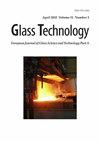Identification of cord sources in glass using CFD
IF 0.3
4区 材料科学
Q4 MATERIALS SCIENCE, CERAMICS
Glass Technology-European Journal of Glass Science and Technology Part a
Pub Date : 2020-11-01
DOI:10.13036/17533546.61.5.vrabel
引用次数: 0
Abstract
Cord appearance in the glass industry is a serious problem in high glass quality tableware production. The increased frequency of sharp cords provoked a serious analysis on cord origin and their elimination at the production line. Optical microscopy and electron microprobe analysis (EMA) were applied as direct methods for cord identification. A computational flow dynamics calculation (CFD) and process data analysis were used to verify the hypothesised source of the inhomogeneity. The hypothesis on origin of ZrO2 free cords containing high amounts of Al2O3 was postulated in relation to the refractory material composition of the forehearth. Calculations showed that the suggested mechanism at temperatures between 1200 and 1300°C was relevant. The hypothesis was supported by a change of chemical character of the cords after partial removal of the poorly resistant material. Also the average cord frequency was reduced on a production line from 53 to 17%. CFD simulations indicated that there may exist an effective mixing strategy on cord dissolution. Increasing stirrer rotation speed in a tempering part of the forehearth had a positive effect on cord disruption. The proposed stirrer set up decreased the cord frequency to less than 2%.利用CFD技术识别玻璃中的线束源
玻璃行业的帘线外观是高玻璃品质餐具生产中的一个严重问题。尖锐线绳出现的频率越来越高,这引发了对线绳来源和生产线上的消除问题的认真分析。光学显微镜和电子探针分析(EMA)是脐带鉴定的直接方法。计算流动力学计算(CFD)和过程数据分析验证了假设的不均匀性来源。提出了含有大量Al2O3的ZrO2自由线的起源与炉膛耐火材料组成有关的假设。计算表明,建议的机制在1200至1300°C之间的温度是相关的。在部分去除耐蚀性差的材料后,声带的化学性质发生了变化,这一假设得到了支持。此外,生产线上的平均电源线频率也从53%降至17%。CFD模拟表明,可能存在一种有效的混合策略来抑制脐带溶解。提高前炉回火部分的搅拌器转速对脐带断裂有积极的影响。所提出的搅拌器设置将脐带频率降低到2%以下。
本文章由计算机程序翻译,如有差异,请以英文原文为准。
求助全文
约1分钟内获得全文
求助全文
来源期刊
CiteScore
0.30
自引率
0.00%
发文量
0
审稿时长
>12 weeks
期刊介绍:
The Journal of the Society of Glass Technology was published between 1917 and 1959. There were four or six issues per year depending on economic circumstances of the Society and the country. Each issue contains Proceedings, Transactions, Abstracts, News and Reviews, and Advertisements, all thesesections were numbered separately. The bound volumes collected these pages into separate sections, dropping the adverts. There is a list of Council members and Officers of the Society and earlier volumes also had lists of personal and company members.
JSGT was divided into Part A Glass Technology and Part B Physics and Chemistry of Glasses in 1960.

 求助内容:
求助内容: 应助结果提醒方式:
应助结果提醒方式:


